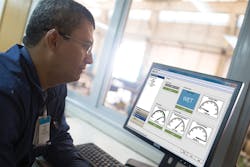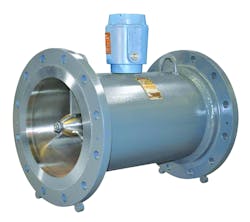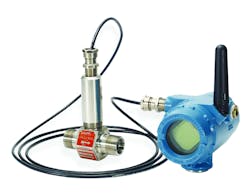Digital transformation strategies for mechanical flow instrumentation
Turbine flowmeters are common in the oil and gas industry for monitoring pipeline flows in a totalizing capacity on small and large lines. The natural lubricity of hydrocarbons helps maintain the rotating mechanism and avoids wear. The scalability of traditional mechanical turbine meters allows them to be used in a wide variety of applications on many line sizes. At the same time there is a twofold downside to these mechanisms. First, they cannot deliver real-time flow readings and, second, there is no capability to send data to an information-gathering or automation system.
Real-time flow measurement may not be needed in these traditional installations, and if it is, differential pressure (DP) flowmeters can provide that capability. Mechanical turbine flowmeters can be retrofitted with a flow indicator, but this requires an additional mechanism similar to an old-fashioned automotive speedometer.
But this doesn’t solve the more complex connectivity issue, requiring technicians to perform the time-consuming and repetitive task of manually gathering data from the field, providing no added value to companies wanting to digitize their operations. Fortunately, instrumentation suppliers have created approaches to overcome this deficiency and provided effective mechanisms to realize digital transformation in brownfield applications.
Figure 1. Industrial turbine flowmeters replace the gear train and counter with sophisticated electronics to deliver improved performance and connectivity.
Modernizing a classic
Purely mechanical totalizing turbine flowmeters use a gear train driven by the rotating turbine to advance a rotary counter. When electronic signal processing can be added, the number of moving parts can be reduced significantly. Typically, a proximity sensor will be built into the housing wall, capable of sensing every time one of the turbine blades passes by and creates an electronic pulse. A pulse counter totalizes the number of rotations to calculate the accumulated flow volume, effectively replacing the rotary counter. More sophisticated electronics can also compare the rate to a clock and calculate a real-time flow rate.
Sophisticated turbine flowmeters available today (see Figure 1) use advanced materials and electronics to deliver a high degree of durability and accuracy. Stainless steel internal assemblies maximize volume throughput with minimal pressure drop, enabling high flow rates without sacrificing a wide turndown range. Improved electronics use two proximity sensors combined with a durable dual-channel preamplifier to guarantee pulse integrity, avoiding missing or double-counted pulses.
Figure 2. Emerson’s Rosemount 705 Wireless Totalizing Transmitter can be retrofitted to an existing mechanical flowmeter to provide improved connectivity and functionality.
Retrofitting older installations
Many existing turbine flowmeters provide no electronic output, or have rudimentary electronics capable of delivering only the most basic totalizing functions. Depending on the application, these may require manual reading, or a totalized reading that can be sent via cable to a larger automation system, programmable logic controller (PLC) or remote terminal unit (RTU).
Older electronic units can be retrofitted with a transmitter (see Figure 2) that can read pulses from the turbine blades using the existing proximity sensor. With advanced signal processing options, it is possible to capture totalized flow data, average flow rate over a specified period of time, and a current real-time flow rate. Using the HART protocol, these transmitters can send any of the multiple variables to a host system and show them visually on a local display. If device networking infrastructure at a remote site is minimal, these transmitters can be outfitted with WirelessHART communication for connecting to a wireless network.
Figure 3. Part of a digital transformation is the ability to gather performance and condition data from a variety of production assets.
A typical use case
As mentioned, turbine flowmeters are often used for measuring various hydrocarbon product flows at production sites or further down the distribution chain. These applications need accurate totalizer readings to determine product movement, more so than flow rate, although there are times when knowing how fast product is moving can be of value.
Consider an oil and gas production site with injection wells. Operators, whether at the site or monitoring remotely, need to know production rates, along with amounts of water and CO2 injected.
Where systems remain largely manual, operators must make trips to the field to record these values by hand rather than focusing on more pressing issues affecting production and safety. Automated injection well monitoring not only gives timely alerts when production is falling below targets, but can also provide indication of plugging wells or flow lines, broken flow lines or overpressuring a well.
Automated wellhead monitoring can send data continuously in real time, or summarize the data, for example, by reporting totals for the past 24 hours to ensure that flows remain within target injection design parameters. Unless the numbers are off target or a problem is being reported, there is no need for an on-site operator visit or manual rounds.
Such remote sites typically involve a variety of instruments that may need to transition from mechanical to electronic. Traditional pressure gauges can be replaced by electronic pressure transmitters or electronic gauges if it is necessary to maintain the characteristic form factor and presentation. Where there are existing turbine flowmeters with rudimentary electronics, they can be upgraded by retrofitting electronic transmitters.
These can be wired to an RTU capable of communicating with a central office, but if wired infrastructure must be installed from scratch, the cost can escalate. Eliminating wiring requirements by using WirelessHART reduces installation costs significantly. Any instrumentation that needs to be added for such an upgrade can likely be purchased as a native WirelessHART device with an internal power module, or a WirelessHART adapter can be added to any HART-enabled instrument transmitter. A WirelessHART network also provides the ability to quickly add a variety of other instruments for monitoring new variables to optimize performance and improve safety.
Along with process instrumentation, many devices are able to monitor the condition and performance of a wide range of production assets, including centrifugal pumps, heat exchangers and pressure relief valves. These new monitoring devices can work in conjunction with pre-configured applications — much like smartphone apps — which can perform sophisticated analysis and display results on dashboards (see Figure 3), all without any custom code writing.
These digital transformation efforts can increase production, reduce costs and increase overall profitability, helping support a company’s top-quartile performance goals and programs. As companies face pressures to improve financial performance while working in tight labor markets, automation can become a critical enabler of success.
Tom Bass is wireless product management director at Emerson Automation Solutions in Shakopee, Minnesota. Bass started his career with Emerson in 2004 and held many roles prior to moving to the wireless business in October 2016. In his current capacity, he is responsible for leading product management for wireless and manages Emerson’s Plantweb pervasive sensing application portfolio. Bass holds a bachelor’s degree in mechanical engineering from Iowa State University and an MBA from the University of Iowa.





